#daidzein
Text
Crystalline Permeable Organic and natural Salts: Via Micropore to Hierarchical Tiny holes.
Homeodomain-interacting protein kinase Three (HIPK3) takes on a crucial role inside cell spreading, apoptosis, along with inflammation. Over-expression involving HIPK3 within immune system cells in rheumatoid arthritis (RA) may be noted. In this study, we all looked into body methylation ranges along with specialized medical features of RA within a China human population. A total of 235 individuals along with RA, 25 together with arthritis (OA), along with 25 coordinated balanced regulates have been hired. The particular methylation standing of more effective CpGs within the differentially methylated place of HIPK3 (cg05501357) ended up being measured making use of focused methylation-sequencing engineering. Your association in between methylation haplotypes as well as the overall methylation reputation associated with HIPK3 together with scientific features was examined employing generalized linear regression. All several CpGs confirmed hypomethylation position within RA bloodstream in comparison with Aw of attraction and also standard men and women (general p= 1.143×10 and FDR= Two.799×10 ), that is like earlier noted substantial phrase of HIPK3 within RA defense cells. Among all more effective CpGs, 33286785 confirmed the best predictive energy with an location under the necessities (AUC) involving 2.829; we all acquired a higher AUC=0.864 once we mixed HIPK3 using anti-citrullinated proteins antibodies (ACPA -) and also rheumatoid issue (Radiation +) in the idea design, showing that when an individual's ACPA is actually damaging, HIPK3 can assist RF being a fresh clinical directory selleck inhibitor to the proper diagnosis of RA. In addition we found out that HIPK3 methylation levels were negatively linked with C-reactive health proteins (CRP; r= -0.07, p= Zero.09). Methylation haplotypes ended up analyzed, and the entire methylation haplotype (FMH; r= 3.Sixteen, p= 2.09) along with complete non-methylation haplotype (FNH; r= Zero.18, p= 3.0061) have been negatively linked using CRP.Going around blood methylation levels inside the protein location regarding HIPK3 works extremely well as being a loyal analytical biomarker along with CRP level sign regarding RA.Your common mucosa's defense mechanisms is composed of tissue-resident and also specifically enrolled leukocytes which could effectively endure an array of microbe along with mechanical problems. Shortly after CD4+ assistant Big t tissue (TH17 cellular material) that leave interleukin 17 (IL-17) have been identified, it turned out discovered that γδT cells may also induce large degrees of this specific pro-inflammatory cytokine. In the past many years, it has become apparent which because of difficult thymic program regarding improvement, γδT cells frequently serve as the key sources of IL-17 in various kinds of -inflammatory diseases while helping within the maintenance of muscle homeostasis within the pores and skin and bowel. Nevertheless it was not as yet we got complete insight into the sophisticated popular features of γδT tissue inside the dental mucosa. Most gingival intraepithelial γδT cells live in the actual junctional epithelium adjacent to the actual dental biofilm, suggesting their prospective function throughout regulating common microbiota. Even so, unpredictable results are already printed in connection with this.
#Ro 20-1724#Polyinosinic acid-polycytidylic acid#CWI1-2#L-Ascorbic acid 2-phosphate sesquimagnesium#Angiotensin II human#XCT790#SL-327#AG-1024#Estrone#Daidzein#Disodium Cromoglycate#D-Cycloserine#Honokiol#O6-Benzylguanine#2#6-Dihydroxypurine#Tetramisole#Terfenadine#Thiostrepton#4-Chloro-DL-phenylalanine#Plumbagin#alpha-Naphthoflavone#Fenretinide#Isoproterenol sulfate#Guanosine 5'-monophosphate#Glycochenodeoxycholic acid#IRAK-1-4 Inhibitor I#Ebselen#TCPOBOP#IPA-3
0 notes
Text
Overview of Endocrine Disruptors
Endocrine Disruptors are natural or man-made chemicals that mimic or interfere with hormones in the body.
Normally, hormone cells within the body have a normal cellular response from target cells.
But then there's the response from target cells that deviates from the regular. This comes from hormone mimics, that bypass into target cells and hormone blockers that interfere with the cell response.

Phytoestrogens is a natural chemical that comes from plants that have hormone-like activity. Phytoestrogens are in genistein and daidzein that are in soy products. These are like soybeans, tofu, tempeh, and soy beverages.
Phytoestrogen interferes specifically with thyroid and estrogen by mimicking hormones. There is a increased risk of developing hypothyroidism due to phytoestrogen and phytoestrogen is easily mistaken by target cells as estrogen.
To avoid endocrine disruptors, be aware when you consume soy, and don’t only eat soy products. Women pre-menopause should especially be aware of this as it affects hormones connected with the female reproduction process.

Triclosan is a man-made chemical that can be found in toothpaste, mouthwash, hand soap, shampoo, lotions, crèmes and deodorant.
Triclosan effects both adults and children, although children more severely, and interferes with target cells focused for estrogen in women, androgen in men, as well as target cells in the thyroid. Triclosan stops target cells from receiving their intended hormones and stops any cellular response.
Triclosan is very common in products, but all products with Triclosan must state on the bottle that it contains it. Avoid buying products with Triclosan in it if you do not have a medical or dental need for antibacterial products.
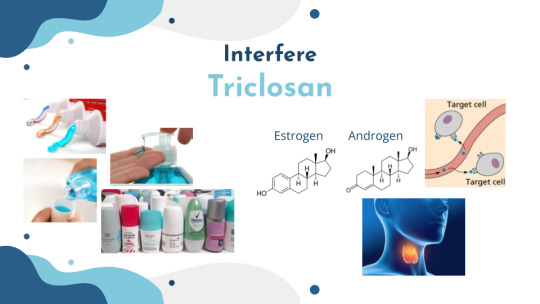
So as a recap, Phytoestrogen and Triclosan are best avoided or consumed only in small amounts unless specifically prescribed or recommended by a professional. Excess of either chemical can lead too imbalances in your hormones that have lasting effects on your body.
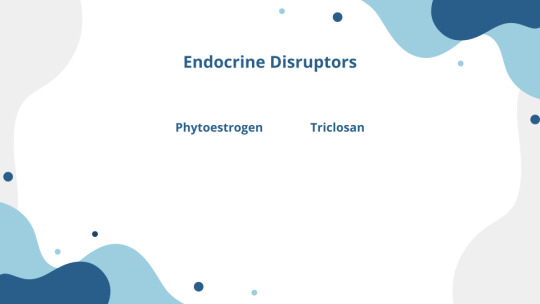
Thanks for reading! If you've got any questions let me know either by reblogging, asking me on my blog, or replying! thanks!
Also thanks to slidesgo for fueling my presentation itch.
6 notes
·
View notes
Text
Plants and animals as containers for medicinal ingredients (Essay)

Sea cucumbers
``Ginseng'' is said to have ``the main medicinal part is the root, and the useful ingredient is a group of saponins called ginsenosides, which are effective against diabetes, arteriosclerosis, and nourishing tonics, and have been taken since ancient times. Because they have the effect of increasing blood pressure, It has been said that people with high blood pressure should refrain from drinking it. However, there are reports that drinking it will lower it, and it is said that it actually has an adjustment effect on the body. It is also said that drinking it can lower blood pressure. It also has a conditioning effect. Once cultivated, Korean ginseng cannot be grown on the same land for 60 years.
Now, there are creatures in the sea that have medicinal properties comparable to ginseng...Sea ginseng...Sea cucumbers. In fact, sea cucumbers are extremely nutritious and have medicinal properties. Another characteristic of sea ginseng is that it contains saponin.
Sea cucumbers contain a well-balanced abundance of nutrients, including vitamins such as vitamins B and E, and minerals such as calcium, iron, and zinc. In China, sea cucumber is used as a treatment for chronic hepatitis and is said to have a tonic effect on the kidneys, prevent arteriosclerosis, recover from decreased sexual function, improve constipation, and have diuretic effects.
In addition, it contains nutritional ingredients that have been attracting attention in recent years, such as collagen and chondroitin, which promote metabolism, keep skin and skin youthful, and act as a cushion to reduce the burden on the knees and lower back that supports body weight. Another characteristic of sea cucumbers is that they contain.
Also, arrowroot(kudzuroot) has been widely used as a main ingredient in crude drugs since ancient times. Kudzu root contains small amounts of isoflavone derivatives such as daidzein, daidzein, and phularin, which have sweating, antipyretic, and antispasmodic effects. Isoflavones also help lower blood cholesterol and control calcium levels in the body, so they are said to be effective against osteoporosis and menopausal symptoms.
Trace ingredients are important. These characteristics are thought to be due to the roots of kudzu growing deep underground and sucking up nutrients from the soil. In the case of potatoes, they are probably about 30 cm below the surface of the earth, so they cannot perform tricks like kudzu.
#Plants and animals as containers for medicinal ingredients#essay#Ginseng#Sea cucumbers#arrowroot#kudzuroot#rei morishita
3 notes
·
View notes
Text
Cannabis Flavonoids: What Are and What Do They Do? A Complete Guide
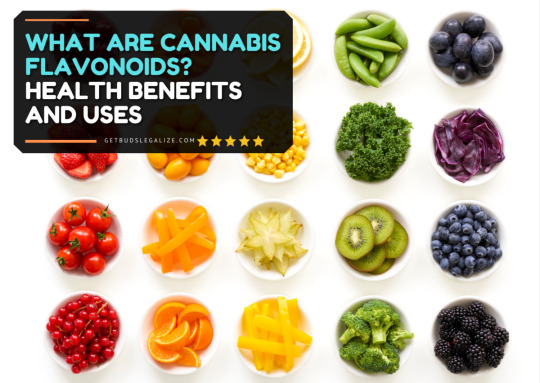


Exploring The Colorful World of Cannabis Flavonoids
Cannabis, with its complex chemistry, offers a treasure trove of compounds that contribute to its diverse effects and potential health benefits. Among these are flavonoids, a class of plant compounds known for their various physiological effects and contributions to flavor and color in many fruits, vegetables, and herbs.What Are Flavonoids in Cannabis?Flavonoids are a diverse group of phytonutrients (plant chemicals) found in fruits, vegetables, grains, tea, wine, and many other plant-based foods. They are responsible for the vivid colors of many fruits and flowers, ranging from red to blue to yellow. Flavonoids are renowned for their antioxidant properties, which means they help protect the body from oxidative stress and inflammation by scavenging harmful free radicals.There are several subclasses of flavonoids, including flavonols (e.g., quercetin, kaempferol), flavones (e.g., apigenin, luteolin), flavanones (e.g., hesperidin, naringenin), flavan-3-ols (e.g., catechins, epicatechins), anthocyanidins (e.g., cyanidin, pelargonidin), and isoflavones (e.g., genistein, daidzein). Each subclass has its unique properties and potential health benefits.What Role Do Flavonoids Play In Cannabis Plants?Flavonoids play several important roles in marijuana plants, contributing to their overall health, protection, and functionality. Here are some key roles that flavonoids play in cannabis:
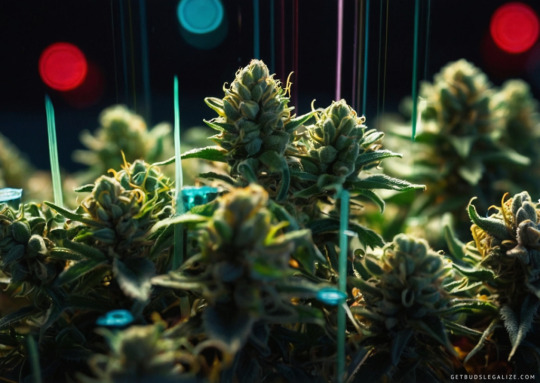
1. UV Protection:Flavonoids act as natural sunscreen for marijuana plants. They absorb ultraviolet (UV) radiation, protecting the plant's delicate tissues from damage caused by excessive exposure to sunlight. This is particularly important for outdoor-grown marijuana plants, which are exposed to varying levels of UV radiation depending on environmental factors.2. Antioxidant Defense:Cannabis flavonoids possess antioxidant properties, meaning they can neutralize harmful free radicals in the plant's cells. Free radicals are unstable molecules that can cause oxidative stress and damage to cellular structures. By scavenging free radicals, flavonoids help protect marijuana plants from oxidative damage and maintain their overall health and vitality.3. Pigmentation:Flavonoids contribute to the pigmentation of flowers and leaves. They are responsible for producing the various colors observed in marijuana plants, including purple, blue, red, and orange hues. The specific combination and concentration of flavonoids present in a cannabis strain determine its unique color profile, which can be influenced by factors such as genetics, environmental conditions, and nutrient availability.4. Anti-Microbial Defense:Flavonoids have been shown to exhibit antimicrobial properties, helping marijuana plants defend against bacterial, fungal, and viral pathogens. By inhibiting the growth of harmful microorganisms, flavonoids contribute to the plant's immune response and resistance to diseases and infections.5. Pollination Attraction:Some flavonoids may play a role in attracting pollinators to cannabis flowers. By emitting specific scents and colors that appeal to bees, butterflies, and other pollinating insects, flavonoids help facilitate the pollination process, which is essential for the reproduction and genetic diversity of marijuana plants.Overall, flavonoids are integral components of the complex chemical profile of cannabis plants. Alongside cannabinoids and terpenes, they contribute to the plant's therapeutic properties, sensory characteristics, and overall resilience in natural environments.As our understanding of cannabis chemistry continues to evolve, further research into the specific roles and effects of flavonoids in cannabis plants may uncover additional insights into their potential benefits for human health and wellness.



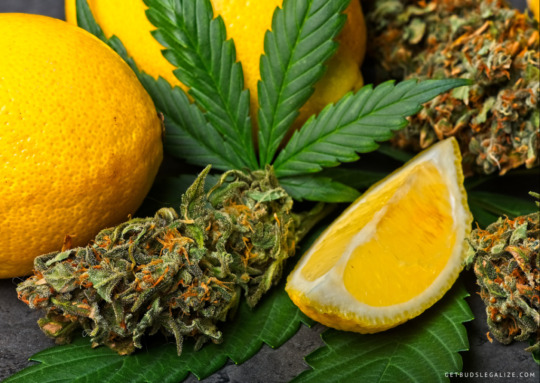
What Potential Health Benefits Do Cannabis Flavonoids Offer?Flavonoids, while less studied compared to cannabinoids like THC and CBD have shown promising benefits. Here are some potential benefits associated with their use:1. Anti-inflammatory properties:Flavonoids in cannabis, such as cannaflavins A and B, have demonstrated strong anti-inflammatory effects. These compounds may help reduce inflammation, which is implicated in various chronic diseases like arthritis, cardiovascular disease, and neurodegenerative disorders.2. Antioxidant activity:Flavonoids are antioxidants that neutralize harmful free radicals in the body. They may protect against chronic diseases such as cancer and cardiovascular disease by preventing oxidative damage to cells.3. Neuroprotective effects:Some flavonoids, such as apigenin, have shown neuroprotective properties in preclinical studies. These compounds may help protect brain cells from damage caused by oxidative stress, inflammation, and neurodegenerative diseases like Alzheimer's and Parkinson's.4. Anti-cancer potential:Certain flavonoids found in cannabis, such as apigenin and quercetin, have been studied for their potential anti-cancer effects. These compounds may inhibit the growth and spread of cancer cells, induce apoptosis (cell death) in cancer cells, and prevent angiogenesis (forming new blood vessels that feed tumors).5. Cardiovascular support:Flavonoids like quercetin have been associated with cardiovascular benefits, including improved blood flow, reduced blood pressure, and protection against heart disease. These effects may be attributed to their anti-inflammatory and antioxidant properties.6. Anti-allergic properties:Some flavonoids, such as cannflavin A, have been found to exhibit anti-allergic effects by inhibiting the release of histamines and other inflammatory mediators. This could potentially benefit individuals with allergies or allergic conditions.It's important to note that much of the research on flavonoids is still in its early stages, and more studies are needed to fully understand their potential health benefits and mechanisms of action.Additionally, the effects of flavonoids may vary depending on factors such as the specific compounds present, their concentrations, and how they interact with other components of the cannabis plant.


Flavonoids and Endocannabinoid System

Some research suggests that certain flavonoids found in cannabis may interact with the ECS, which is a complex network of receptors, enzymes, and endocannabinoids that play a crucial role in regulating various physiological processes, including mood, memory, appetite, and pain sensation.For instance, flavonoids like quercetin and kaempferol have been found to have a mild affinity for cannabinoid receptors, particularly CB2 receptors, which are primarily located in immune cells and tissues associated with inflammation. By interacting with these receptors, flavonoids may modulate immune responses and inflammation.Moreover, flavonoids can also influence the activity of enzymes involved in the synthesis and degradation of endocannabinoids, such as fatty acid amide hydrolase (FAAH) and monoacylglycerol lipase (MAGL). By regulating the levels of endocannabinoids like anandamide and 2-arachidonoylglycerol (2-AG), flavonoids may indirectly affect ECS signaling and function.However, it's important to note that research on flavonoids and their interaction with the ECS is still in its early stages, and much more investigation is needed to fully understand the mechanisms and potential therapeutic applications.Additionally, the effects of flavonoids can vary depending on factors such as their concentration, the presence of other cannabis compounds (like cannabinoids and terpenes), and individual differences in metabolism and physiology.

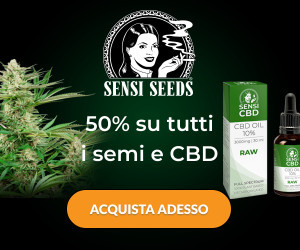
List Of Flavonoids In Cannabis And Their Potential BenefitsCannabis contains a variety of flavonoids, although research on them is still ongoing. Some of the flavonoids identified in cannabis include:
1. Cannflavins:
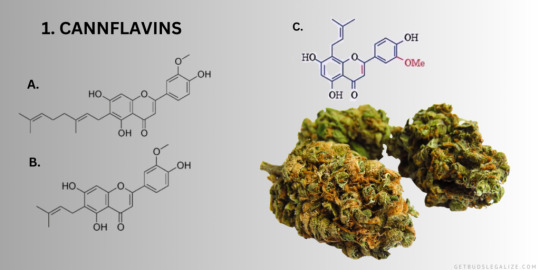
Among the unique flavonoids found in cannabis are the cannflavins, namely Cannflavin A, Cannflavin B, and Cannflavin C. These compounds have garnered attention for their potential anti-inflammatory properties. Cannflavin A, in particular, has shown promise in preclinical studies for its potent anti-inflammatory effects, surpassing those of aspirin in some research.
2. Apigenin:

Another noteworthy flavonoid present in cannabis is apigenin. This compound is widely known for its anti-inflammatory and antioxidant properties. Studies suggest that apigenin may contribute to the overall therapeutic effects of cannabis, potentially enhancing its medicinal value.
3. Luteolin:

Luteolin is a flavone commonly found in various plants, including cannabis. Studies suggest that luteolin may exert neuroprotective, anti-inflammatory, and anticancer effects. Its presence in cannabis adds to the diverse array of compounds that contribute to the plant's medicinal properties.
4. Kaempferol:
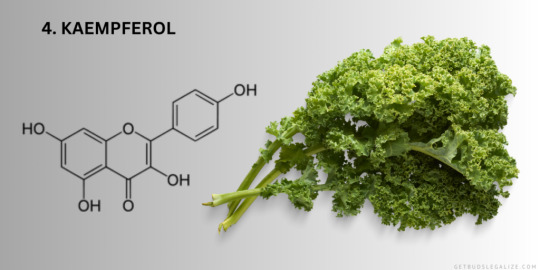
Kaempferol is another flavonoid identified in cannabis, celebrated for its potential health benefits. Research indicates that kaempferol may possess anti-cancer, anti-inflammatory, and neuroprotective properties, making it a compound of interest in the realm of medicinal cannabis.
5. Quercetin:

Quercetin is a flavonoid abundant in various fruits and vegetables, including cannabis. Known for its antioxidant and anti-inflammatory properties, quercetin has been investigated for its potential role in supporting cardiovascular health and reducing inflammation-related conditions.
6. Orientin:
Read the full article
0 notes
Text
0 notes
Text
Soy Isoflavones Market: Key Players and Strategies from 2023 to 2030

The global soy isoflavones market is expected to grow from US$ 1.49 billion in 2023 to US$ 2.41 billion by 2030, at a CAGR of 6.16% during the forecast period. It is true that isoflavones are organic compounds, mostly present in different types of beans. Soybeans and products made from them are incredibly rich sources of isoflavones because they are the physiologically active components of soybeans, or isoflavones.
These chemicals, which are often referred to as phytoestrogens, work similarly to the female hormone estrogen. Because of this property, soy isoflavones are an active ingredient in many products that support the health of women. The two primary isoflavones found in soy are daidzein and genistein.
Request A Report Sample To Gain Comprehensive Insights! https://absolutemarketresearch.com/Global-Soy-Isoflavones-Market/544/request-sample
Drivers For Soy Isoflavones In The Market:
The strong and increasing demand for soy isoflavones from post-menstrual women drives the market. This need arises from the fact that women at this age have a marked decrease in estrogen, leading to various problems such as hot flashes, excessive perspiration, and weight gain.
Two serious issues that decreased estrogen levels may cause are osteoporosis and heart difficulties. Compared to operations such as hormone replacement therapy, soy isoflavones provide less risk to the health of the user.
Key Takeaways:
The global soy isoflavones market is expected to grow from US$ 1.49 billion in 2023 to US$ 2.41 billion by 2030, at a CAGR of 6.16% during the forecast period.
The market growth is attributed to the increasing awareness of the health benefits of soy isoflavones, rising demand for soy-based food and beverages, and growing application of soy isoflavones in the pharmaceutical and nutraceutical industries.
North America is expected to remain the largest market for soy isoflavones, followed by Asia Pacific and Europe.
Regional Outlook and Analysis:
North America is expected to remain the largest market for soy isoflavones, owing to the increasing awareness of the health benefits of soy isoflavones and the growing demand for soy-based food and beverages.
Asia Pacific is expected to grow at the fastest CAGR during the forecast period, owing to the rising disposable incomes and increasing awareness of the health benefits of soy isoflavones.
Europe is expected to witness significant growth in the soy isoflavones market, owing to the increasing demand for soy-based food and beverages and the growing application of soy isoflavones in the pharmaceutical and nutraceutical industries.
Key Players:
ADM
Solbar Industries
Alpro
Frutarom
Shengyuan
FutureCeuticals
Fujicco
Soy Isoflavones Market segmentation by category:
By Raw-material type:
Genetically Modified (GM)
Non-Genetically Modified (Non-GM) Soy
By The Application:
Soy-Beverages
Functional Foods
Healthcare Products
Dietary
Menopausal
Bone Health
Others Supplements
By Product Type:
Genistein
Daidzein
Glutenin
By Region:
North America
Latin America
Europe
Asia Pacific
Oceania
Middle East and Africa
By Distribution Channel:
Pharmacies/Drugstores
Health & Beauty stores
Hypermarket/Supermarket
Direct Selling
Online
0 notes
Text
Daily Dietary Sources of Flavonoids: An Overview by PA Cheyanne Mallas

Flavonoids are a diverse group of plant secondary metabolites that have gained significant attention due to their potential health benefits says Cheyanne Mallas PA. These compounds are widely distributed in fruits, vegetables, grains, herbs, and beverages, and have been associated with various physiological effects, including antioxidant, anti-inflammatory, and anticancer properties. This paper aims to provide an overview of the daily dietary sources of flavonoids and their potential health implications says Cheyanne Mallas PA.
Fruits and Vegetables:
Fruits and vegetables are rich sources of flavonoids. Citrus fruits such as oranges, lemons, and grapefruits are particularly high in flavonoids, with compounds like hesperidin and naringenin being commonly found. Berries, including strawberries, blueberries, and raspberries, are also excellent sources of flavonoids, such as anthocyanins and flavanols. Other flavonoid-rich fruits include apples, pears, cherries, and grapes. Vegetables like onions, broccoli, kale, and spinach also contain appreciable amounts of flavonoids, such as quercetin and kaempferol.
Herbs and Spices:
Herbs and spices are known for their strong flavors and aromatic properties, but they are also significant sources of flavonoids. Parsley, thyme, oregano, and mint are examples of herbs rich in flavonoids, including apigenin and luteolin. Turmeric, a spice commonly used in Indian cuisine, contains curcumin, a flavonoid with potent antioxidant and anti-inflammatory properties. Other spices like cinnamon, ginger, and cloves also contain varying amounts of flavonoids.
Grains and Legumes:
Although fruits and vegetables are often considered the primary sources of flavonoids, whole grains and legumes also contribute to the daily intake. Foods like buckwheat, quinoa, and oats contain significant amounts of flavonoids, such as rutin and quercetin. Legumes like soybeans, lentils, and chickpeas are also good sources of flavonoids, including isoflavones like genistein and daidzein.
Beverages:
Several beverages are known for their flavonoid content, particularly tea and cocoa. Green tea, black tea, and white tea are all derived from the Camellia sinensis plant and contain flavonoids called catechins. These compounds have been associated with numerous health benefits, including cardiovascular protection and anticancer effects. Cocoa and dark chocolate are also rich in flavonoids, such as epicatechin and procyanidins, which have been linked to improved vascular health and cognitive function.
Conclusion:
Flavonoids are bioactive compounds found in a wide range of foods, particularly fruits, vegetables, herbs, spices, grains, legumes, and beverages. Consuming a varied diet rich in these sources can provide individuals with a consistent supply of flavonoids, which may contribute to the prevention of chronic diseases and the promotion of overall health says Cheyanne Mallas PA. Further research is needed to fully understand the optimal intake levels and the specific health benefits associated with different flavonoid subclasses. Nonetheless, incorporating these dietary sources into daily nutrition can be a valuable strategy for enhancing health and well-being.
1 note
·
View note
Text
Thơm Ngon Tê Lưỡi CHAO MÔN TÂY NINH Đậm Tình Hương Vị
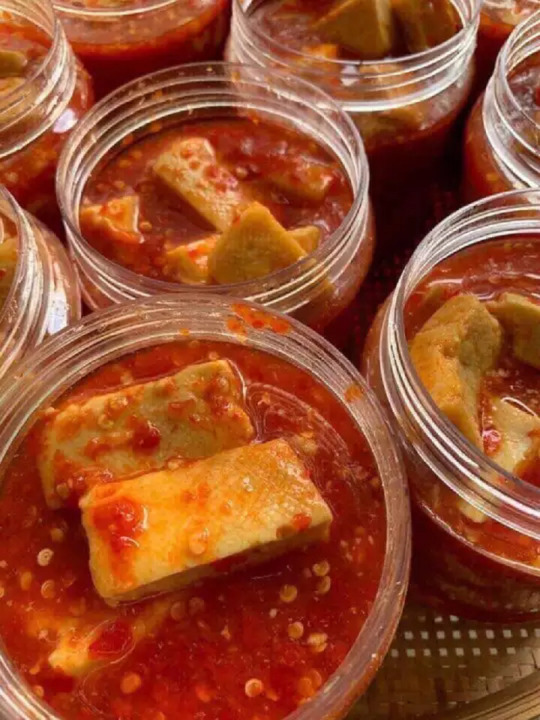
Chao môn Tây Ninh ai đã ăn qua một lần sẽ nghiện và “đổ đứ đừ”. Đây là nước chấm được làm từ đậu nành, kết hợp với các gia vị khác đi kèm, cho lên men đúng cách đem đến cảm giác ngon miệng, deo dẻo và vị đậm đà khó tả.
Hãy cùng Cơ Sở Bánh Tráng Muối Như Bình tìm hiểu về đặc sản trứ danh này trong bài viết, ngoài ra chúng tôi còn cập nhật nhiều Đặc Sản Tây Ninh nổi tiếng trong cùng chuyên mục, nếu có hứng thú, dành thời gian đọc qua nhé!
Một Vài Nét Về Chao Môn Tây Ninh
Không phải ngẫu nhiên mà chao môn Tây Ninh lại nổi tiếng gần xa, khi mà hầu như du khách tới mảnh đất Thánh này đều mua một vài hủ về làm quà. Chao môn nức tiếng thơm ngon và béo ngậy ngay từ khâu chọn nguyên liệu kỹ lưỡng. Đậu nành và khoai môn là hai thành phần chính tạo nên “linh hồn” của món chao.
Bên cạnh khâu chọn nguyên liệu thì công nghệ chế biến lên men vi sinh yêu cầu phải có kinh nghiệm thì mới tạo được món chao môn ngon. Nước chao phải dịu, tạo hương vị cay không thể thiếu ớt tươi băm nhuyễn, đặc biệt phải có rượu kích thích vị ngon đặc trưng.

Cách làm chao môn Tây Ninh rất cất công, tốn khá nhiều thời gian. Khoai môn sau khi gọt vỏ, rửa sạch, cắt thành từng khối vuông vừa ăn. Đem khoai môn luộc chín, trộn với đậu hũ và ủ từ 2-4 ngày cho chao lên men.
Chưa dừng lại ở đó, bạn còn phải làm nước ngâm chao. Đây được xem là công đoạn khó, đòi hỏi kinh nghiệm quyết định tới sự thơm ngon của thành phẩm. Ngâm chao với nước lên men khoảng 8-15 ngày cho tới khi chao chín.
Ăn Chao Môn Tây Ninh Có Tốt Không?
Chao môn Tây Ninh làm bằng gì? Thành phần chao môn không thể thiếu khoai môn. Bản chất khoai môn không chứa cholesterol, nhưng vẫn chứa các chất béo tự nhiên rất tốt cho sức khỏe.
Thêm vào đó, khoai môn lại chứa nhiều chất xơ, khoáng chất cần thiết, vitamin và hàm lượng sodium thấp, rất phù hợp cho những người đang ăn kiêng hoặc ăn chay.
Thêm vào đó, trong đậu hũ có chứa các hợp chất isoflavone, genistein và daidzein, có công dụng chống oxy hóa và giảm nguy cơ mắc các bệnh ung thư. Ngoài ra chao còn là nguồn cung cấp canxi, mangan.
Đây là hai dưỡng chất quan trọng, giúp hỗ trợ chắc xương, giảm nguy cơ loãng xương. Bên cạnh đó, ăn chao môn Tây Ninh còn giảm nguy cơ mắc bệnh đái tháo đường, glycemic index thấp, điều chỉnh lượng đường trong máu.
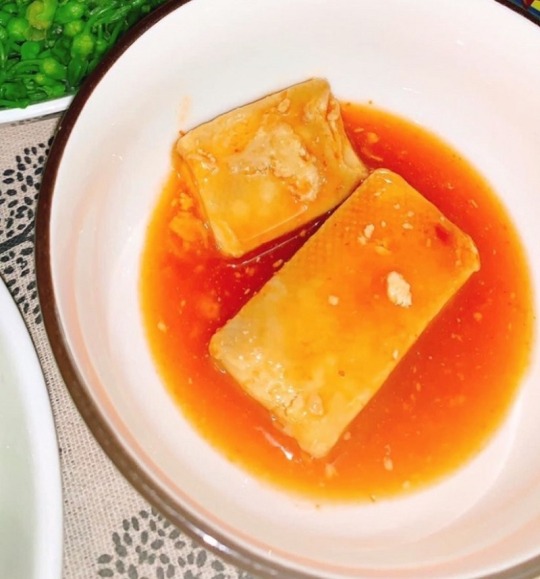
Một Số Món Ăn Thơm Ngon Kết Hợp Với Chao Môn
Có rất nhiều món ngon được kết hợp với chao môn Tây Ninh, làm nên bữa ăn gia đình thêm phần đậm vị khó tả phải kể tới là:
Thịt Heo Kho Chao
Thịt heo thơm béo cùng với nước kho chao đậm đà, làm cho mọi thành viên gia đình tấm tắc khen ngon. Và món ăn sẽ tăng hương vị đặc trưng khi gia thêm chút ớt, chút tiêu phù hợp cho tiết trời se lạnh.
Gà Nướng Chao
Đây là món ăn được nhiều mẹ nội trợ chế biến cho các thành viên gia đình mỗi dịp cuối tuần. Cắn miếng thịt gà hòa quyện với lớp chao môn Tây Ninh, ngon khó tả làm cho bạn khó mà từ chối.
Vú Heo – Vú Dê Nướng Chao
Ngoài thịt gà, bạn có thể dùng vú heo, vú dê để nướng chao. Sự kết hợp hài hòa giữa hai nguyên liệu này tạo nên món ăn tấm tắc ngon, nhâm nhi cuối tuần cùng bạn bè. Những miếng vú mềm đã được ướp khoai môn đậm vị mà vẫn giữ được vị ngọt tự nhiên của vú heo, vú dê.
Vịt Nấu Chao
Thêm một món ăn khá quen thuộc với các bà nội trợ là món vịt nấu chao. Chỉ cần dành một chút tỉ mỉ, chịu khó thì sẽ có món thành phẩm có hương vị độc đáo, đậm vị và cay nhẹ.
Những buổi sum họp gia đình, các mẹ trổ tài nấu món vịt nấu chao này chắc chắn mọi thành viên tấm tắc khen không ngớt lời. Và món ăn sẽ ngon hơn khi kết hợp với bánh mì hoặc bún.
Lẩu Chao Chay
Sự kết hợp giữa các nguyên liệu như nấm đông cô, bông cải xanh, cà rốt, đậu hũ non… cùng với chao môn và gia vị đi kèm tạo thành món lẩu chao chay hấp dẫn, giàu dưỡng chất. Đây là món lẩu phù hợp cho những người ăn chay hoặc trong chế độ giảm cân. Mùa đông được thưởng thức món lẩu chao chay là lựa chọn phù hợp và lý tưởng.
Chao Môn Tây Ninh Mua Ở Đâu Chất Lượng?
Như đã đề cập ở trên, chao môn rất ngốn nhiều thời gian để thực hiện và chế biến. Nếu không có kinh nghiệm, thực hiện không đúng cách thì thành phẩm không đạt yêu cầu. Cách tốt nhất, bạn nên mua ở các cửa hàng chuyên bán chao môn.

Chao môn ngon mua ở đâu? Chao môn Tây Ninh giàu giá trị dinh dưỡng, được chế biến từ các nguyên liệu thiên nhiên. Khách hàng nên mua ở cửa hàng có địa chỉ rõ ràng, có website hay trang bán hàng điện tử để chọn mua sản phẩm đúng chuẩn chất lượng.
Chao môn sau khi sử dụng, bảo quản ở ngăn mát tủ lạnh hoặc ở nơi khô ráo, thoáng mát, tránh ánh nắng mặt trời. Ngoài chao môn, ở đất Thánh còn có nhiều đặc sản khác nữa, du khách có thể ghé Bánh Tráng Như Bình để lựa chọn và mua một ít về làm quà cho người thân và bạn bè.
Hi vọng qua bài viết chia sẻ này giúp cho bạn có thêm nhiều kiến thức về chao môn Tây Ninh. Vị chao beo béo, ăn chay, ăn mặn đều được, dùng để chấm rau củ hay chế biến các món ăn khác đều ngon khó tả. Đó cũng là lý do mà hầu như du khách đến Tây Ninh đều mua một ít chao môn về làm quà.
Read the full article
0 notes
Text
16 Tác dụng và Tác hại của Đậu nành đối với sức khỏe bạn nên lưu ý
Làm đẹp da, ngăn ngừa ung thư vú, hỗ trợ điều trị bệnh tiểu đường, giúp xương chắc khỏe, cải thiện các triệu chứng mãn kinh… là những công dụng của đậu nành mang đến cho người sử dụng, đặc biệt là phụ nữ. Tuy nhiên, tồn tại song song với nó sẽ là những tác hại không lường nếu bạn sử dụng quá nhiều và không đúng cách. Hãy cùng Ực đi tìm hiểu sâu hơn về tác dụng và tác hại của đậu nành để đảm bảo sức khỏe bạn nhé.
I. Thành phần dinh dưỡng của đậu nành
Đậu nành là một loại cây thuộc họ đậu được trồng nhiều ở các nước nhiệt đới trọng khu vực Châu Á. Hạt của cây được sử dụng làm thực phẩm nhờ có hàm lượng dinh dưỡng cao. Nó có thể được sử dụng dưới các dạng dùng nguyên hạt, xay sữa uống, làm đậu hũ, tào phớ, ủ lên men, làm nước tương, chế biến dầu ăn hoặc sử dụng làm thực phẩm chay thay thế cho đạm động vật.
Các thành phần dưỡng chất có trong một cốc hạt đậu nành ( khoảng 155g ) bao gồm:
Calo: 189 kcal
Chất xơ: 8.1g
Carbohydrate: 11,5g
Vitamin: B6, C, E, K
Protein: 16,9g
Chất béo: 8.1g
Khoáng chất: Sắt, đồng, magie, photpho, kẽm, mangan
Isoflavones daidzein
Genistein
Chất xơ prebiotic
Niacin
Các chất khác: Thiamine, Folate, Riboflavin
II. Đậu nành có tác dụng gì?
1. Đậu nành giữ cho cholesterol xấu duy trì ở mức thấp
Một số nghiên cứu cho thấy một chế độ ăn giàu thực phẩm từ đậu nành, cụ thể những người tiêu thụ 20-133g protein từ đậu nành có thể giảm khoảng 7 - 10% cholesterol LDL xấu. Không những thế, dùng thực phẩm từ đậu nành còn làm tăng cholesterol HDL tốt tới 3%. Do đó, những người mắc tiểu đường tuýp 2, béo phì, cholesterol cao,... được khuyên là nên bổ sung đậu nành vào chế độ ăn của mình.
Tiêu thụ đậu nành đều đặn có thể giúp cơ thể đào thải bớt lượng mỡ dư thừa trong máu, ngăn ngừa và hỗ trợ điều trị máu nhiễm mỡ.
2. Đậu nành tốt cho tim mạch
Một cuộc nghiên cứu về tác dụng của đậu nành với sức khỏe tim mạch đã ghi nhận, những người tiêu thụ 20-133g protein từ đậu nành mỗi ngày có thể giảm được hàm lượng cholesterol xấu trong máu xuống từ 7 – 10%. Cũng theo Hiệp hội FDA Hoa Kỳ, bổ sung 25g protein đậu nành vào thực đơn hàng ngày có thể giảm được đáng kể hàm lượng chất béo bão hòa trong cơ thể. Những tác dụng trên cho phép người sử dụng có thể ngăn ngừa được nguy cơ bị bệnh xơ vữa động mạch cũng như nhiều vấn đề khác liên quan đến tim mạch.
Một vài đánh giá trong thời gian gần đây cho thấy nếu chế độ ăn giàu đậu nành sẽ giúp giảm nguy cơ mắc bệnh tim xuống 16% và nguy cơ đột quỵ xuống còn 20%. Chẳng những thế, đậu nành còn làm giảm nguy cơ tử vong do bệnh tim tới 15%.
3. Đậu nành điều hòa đường huyết
Đậu nành là thực phẩm lý tưởng cho người bị tiểu đường. Sở hữu hàm lượng chất xơ dồi dào, Isoflavone trong đậu nành có thể làm giảm lượng đường trong máu, giảm tình trạng kháng insulin, góp phần kiểm soát tốt các triệu chứng của bệnh.
4. Đậu nành điều hoà huyết áp
Hầu hết các nghiên cứu đều ghi nhận, người bị cao huyết áp tiêu thụ protein từ đậu nành có thể làm giảm chỉ số huyết áp tâm thu xuống từ 4-8 mmHg và giảm huyết áp tâm trương xuống từ 3-5 mmHg. Điều này sẽ giúp người bệnh kiểm soát huyết áp tốt hơn và giảm thiểu nguy cơ gặp các biến chứng nguy hiểm.
5. Đậu nành giúp giảm triệu chứng mãn kinh
Chất isoflavone trong đậu nành có khả năng liên kết với các thụ thể estrogen trong cơ thể. Vào thời kỳ mãn kinh của nữ giới, nồng độ estrogen suy giảm gây ra các triệu chứng cáu kỉnh, mệt mỏi, trầm cảm, khô âm đạo, đau khớp, bốc hỏa,... Isoflavone trong đậu nành liên kết với các thụ thể estrogen giúp giảm một phần mức độ nghiêm trọng của các triệu chứng kể trên.
Phụ nữ trong giai đoạn mãn kinh, dễ xảy ra tình trạng thiếu hụt protein. Việc thiết hụt protein là nguyên nhân chính khiến cho mái tóc bị khô giòn, gãy rụng nhiều. Bằng việc tăng cường các sản phẩm từ đậu nành trong bữa ăn hàng ngày, bạn đã bổ sung cho cơ thể một nguồn protein dồi dào, giúp mái tóc được chắc khỏe, dày mượt hơn.
Ngoài ra, thành phần isoflavone trong đậu nành cũng giúp cân bằng hormone trong cơ thể, giúp phái đẹp ngăn ngừa rụng tóc. Hợp chất genistein được tìm thấy trong thực phẩm này lại có tác dụng giảm gãy rụng tóc bằng cách bảo vệ nang tóc và tăng cường bổ sung tinh chất dưỡng ẩm cho da đầu.
6. Đậu nành tốt cho hệ xương
Đậu nành chứa hàm lượng canxi vượt trội hơn so với những thực phẩm khác. Do vậy mà việc tiêu thụ các sản phẩm từ đậu nành với tần suất đều đặn sẽ giúp xương khớp cứng cáp, khỏe mạnh hơn và phòng chống được nhiều bệnh lý về xương khớp, đặc biệt là loãng xương.
Cùng với đó, bổ sung Estrogen từ đậu nành cũng có tác dụng làm chậm lại tiến trình phá hủy xương khi phụ nữ bước vào giai đoạn tuổi mãn kinh.
7. Đậu nành giúp giảm nguy cơ mắc các bệnh ung thư
Nghiên cứu quan sát hiện tại cho thấy thực phẩm đậu nành có thể làm giảm nguy cơ mắc bệnh ung thư vú và ung thư tuyến tiền liệt. Tuy nhiên, tác dụng của hạt đậu nành đối với nguy cơ ung thư hiện vẫn đang được tranh luận cao. Các nghiên cứu trên động vật cho kết quả hỗn hợp liên quan đến isoflavone của đậu nành và tăng trưởng khối u, đặc biệt là đối với ung thư vú.
Một đánh gía 35 nghiên cứu cho thấy có mối liên quan đáng kể giữa sử dụng hạt đậu nành với giảm nguy cơ ung thư vú ở phụ nữ ở các nước châu Á, nhưng không tìm thấy mối liên quan nào đáng kể giữa việc sử dụng đậu nành và ung thư vú ở phụ nữ các nước phương Tây.
Hơn nữa, các nghiên cứu về mối liên quan giữa việc sử dụng hạt đậu nành với nguy cơ mắc ung thu tuyến tiền liệt thấp hơn khoảng 30%.
Tác dụng chống ung thư của đậu nành có thể là do khả năng hoạt động của isoflavone- hoạt động như chất chống oxy hóa, cũng như lunasin giúp thúc đẩy sự chết tế bào ung thư trong các nghiên cứu trên ống nghiệm và động vật. Tuy nhiên, vẫn cần có nhiều nghiên cứu sâu hơn về mối liên quan giữa đậu nành và ung thư.
8. Đậu nành giúp cải thiện khả năng sinh sản
Đậu nành có vẻ có lợi cho khả năng sinh sản, miễn là không ăn quá nhiều. Phụ nữ trải qua quá trình thụ tinh trong ống nghiệm tiếp xúc với BPA trong môi trường có nhiều khả năng mang thai hơn nếu họ cũng ăn đậu nành. Nguyên nhân có thể là do isoflavone trong đậu nành giúp trung hòa các tác động gây rối loạn nội tiết của BPA.
III. Tác hại của đậu nành đối với cơ thể nếu bạn ăn quá nhiều
Mặc dù những tác dụng của đậu nành là không còn gì phải bàn cãi nhưng ăn đậu nành nhiều có tốt không lại là việc đáng suy ngẫm. Về cơ bản, đậu nành và các chế phẩm của nó chỉ có tác dụng tốt nhất khi được ăn với một lượng vừa đủ. Một khi ăn quá nhiều nành sẽ gây ra những tác hại khôn lường như:
1. Đậu nành làm chức năng tuyến giáp bị ức chế
Theo ThS. Bác sĩ nội trú (BSNT) chuyên ngành ung bướu Nguyễn Xuân Tuấn, “Người bệnh tuyến giáp tránh sử dụng các sản phẩm đậu nành đã qua chế biến như bột đậu nành, bột protein tăng cơ. Không lạm dụng những sản phẩm đậu nành và thay thế cho những món ăn khác. Chỉ sử dụng những chế phẩm chưa qua chế biến quá nhiều như sữa đậu nành, đậu phụ tươi, miso… Không nên ăn quá nhiều và thường xuyên.”
Thực phẩm đậu nành không ảnh hưởng đến chức năng tuyến giáp ở những người có tuyến giáp khỏe mạnh. Nhưng nếu bạn có một tuyến giáp kém hoạt động, thực phẩm từ đậu nành đã được chứng minh là có thể cản trở cơ thể hấp thụ thuốc tuyến giáp. Vì vậy, nên đợi ít nhất bốn giờ sau khi ăn các sản phẩm từ đậu nành để uống thuốc tuyến giáp đã được bác sĩ kê đơn. ThS.BSNT Nguyễn Xuân Tuấn cho biết: Lượng đậu nành cho phép với người bệnh tuyến giáp là 30mg/ngày.
2. Ăn nhiều đậu nành làm tăng gánh nặng cho thận
Đậu nành rất giàu oxalat - chất gây ra sỏi thận. Nghiên cứu trên một tạp chí của Mỹ chỉ ra: khi oxalat của đậu nành được hấp thụ vào cơ thể nó sẽ bài tiết vào nước tiểu nhưng không có khả năng chuyển hóa. Ở trong nước tiểu, nó cùng với canxi tạo thành muối không hòa tan của canxi oxalat rồi kết tủa sinh ra sỏi thận.
Bệnh nhân suy thận cần có chế độ ăn ít đạm, trong khi đó đậu nành và các chế phẩm của chúng là những thực phẩm giàu chất đạm, các chất chuyển hóa sẽ làm tăng gánh nặng cho thận.
3. Ăn nhiều đậu nành làm hạn chế khả năng hấp thụ canxi
Phần lớn các sản phẩm từ đậu nành như: đậu hủ, sữa đậu nành, tương đậu nành… cung cấp protein xây dựng độ vững chắc cho xương. Bên cạnh đó, đậu nành chứa thành phần khác làm ngăn cản hấp thụ canxi, đó là oxalate. Nếu dùng nhiều đậu nành nhưng ăn ít canxi thì sẽ gây thiếu hụt canxi gây hại cho xương. Liên quan đến tăng trưởng xương thì bên cạnh ý kiến cho rằng đậu nành tác hại thì có ý kiến cho rằng nhờ 2 thành phần genistein và daidzein mà đậu nành giúp xương khỏe mạnh. Trong đậu nành có canxi nhưng khi chế biến dưới dạng nước uống thì canxi sẽ lắng đọng bên dưới chai (dù có lắc chai thì cũng sẽ lắng đọng lại), tốt nhất là dùng đậu nành chế biến dạng đặc như đậu hủ để có đủ lượng canxi.
4. Đậu nành làm ảnh hưởng đến việc hồi phục sau phẩu thuật, giảm sức đề kháng
Những người sau khi phẫu thuật hoặc ốm đau, sức đề kháng của cơ thể yếu và chức năng tiêu hóa không tốt. Lúc này, nên hạn chế sử dụng sữa đậu nành, đặc biệt là sữa đậu nành lạnh vì dễ bị buồn nôn, tiêu chảy và các triệu chứng khác.
Tốt nhất bệnh nhân nên sử dụng sữa chua trong thời gian phục hồi, có thể thúc đẩy tiêu hóa và bảo vệ chức năng đường tiêu hóa.
5. Đậu nành làm phát tác bệnh gout
Gout là bệnh do rối loạn chuyển hóa purin, trong khi đó đậu nành rất giàu purin. Purin là chất ưa nước nên đậu nành sau khi xay thì hàm lượng purin cao gấp mấy lần so với các sản phẩm làm từ đậu nành khác.
Vì vậy, người bệnh gout nên hạn chế uống sữa đậu nành. Nhưng không có nghĩa là tuyệt đối tránh dùng sữa đậu nành mà cần kiểm soát số lượng, để phòng và điều trị bệnh gout.
6. Ăn nhiều đậu nành làm thiếu i-ốt
Đậu phụ không chỉ là thực phẩm bổ dưỡng, mà còn có tác dụng trong việc điều trị, phòng chống xơ vữa động mạch. Điều này là bởi vì đậu phụ có chứa một chất gọi là saponin. Saponin có thể ngăn chặn sự hình thành của peroxit lipid, là nguyên nhân chính của xơ vữa động mạch.
Tuy nhiên, có một vấn đề được đưa ra là saponin sẽ dẫn đến bài tiết I-ốt trong cơ thể. Do đó, ăn đậu phụ trong một thời gian dài có thể dẫn đến thiếu hụt iốt.
7. Ăn nhiều đậu nành gây thiếu máu
Đậu nành rất giàu protein, ăn nhiều đậu nành trong thời gian dài không chỉ cản trở sự hấp thụ sắt của cơ thể mà còn dễ dẫn đến chứng khó tiêu, chướng bụng, tiêu chảy và các triệu chứng khác.
Chúng cũng khiến cho quá trình phân giải protein trở nên quá tải từ đó ảnh hưởng đến quá trình hấp thụ dinh dưỡng, không thích hợp cho người bị thiếu máu.
8. Ăn nhiều đậu nành gây rối loạn tình dục nam
Theo Neha Sanwalka - nhà dinh dưỡng học Ấn Độ và một số báo cáo của trường học Y tế công cộng Harvard, Mỹ, thì nếu tiêu thụ quá nhiều đậu nành trong các bữa ăn hàng ngày sẽ làm cho số lượng tinh trùng của nam giới giảm đáng kể. Các sản phẩm đậu nành có ảnh hưởng đến hệ thống sinh sản nam giới, đặc biệt là ảnh hưởng xấu đến sự sinh tinh, rối loạn chức năng cương cứng.
Như vậy, với những chia sẻ trên đây các cậu đã có thể thấy ăn đậu nành nhiều là không tốt. Ực không nói rằng đậu nành là không tốt. Tuy nhiên, để phát huy được công dụng của nó với sức khỏe, tốt nhất cậu không nên ăn quá nhiều đậu nành mà chỉ nên duy trì ở một lượng vừa đủ mà thôi nhé.
0 notes
Text
A link involving contact with Middle Far east Breathing Symptoms (MERS) and fatality price regarding Coronavirus Disease 2019 (COVID-19).
#Ro 20-1724#Polyinosinic acid-polycytidylic acid#CWI1-2#L-Ascorbic acid 2-phosphate sesquimagnesium#Angiotensin II human#XCT790#SL-327#AG-1024#Estrone#Daidzein#Disodium Cromoglycate#D-Cycloserine#Honokiol#O6-Benzylguanine#2#6-Dihydroxypurine#Tetramisole#Terfenadine#Thiostrepton#4-Chloro-DL-phenylalanine#Plumbagin#alpha-Naphthoflavone#Fenretinide#Isoproterenol sulfate#Guanosine 5'-monophosphate#Glycochenodeoxycholic acid#IRAK-1-4 Inhibitor I#Ebselen#TCPOBOP#IPA-3
1 note
·
View note
Text
The Health Benefits of Soybean Extract Powder: A Powerful Dietary Supplement
Soybean extract powder is a type of dietary supplement made from soybeans. It is widely used for its many health benefits, including lowering cholesterol levels, boosting immune function, and reducing inflammation. In this blog post, we will explore the benefits of soybean extract powder and how it can improve your overall health.
What is the main ingredient of soybean extract powder?
Soybean isoflavones are a group of compounds found naturally in soybeans. The main types of soybean isoflavones are genistein, daidzein, and Glycitein.
What is Soybean Extract Powder?
Soybean extract powder is made from soybeans, a rich plant-based protein, healthy fats, and dietary fiber source. Soybeans are also high in isoflavones, which are phytoestrogens that have been shown to have various health benefits.
To make soybean extract powder, soybeans are dehulled and ground into a fine powder. This powder is then processed using various techniques to remove impurities and concentrate the beneficial compounds in soybeans, including isoflavones, saponins, and phytosterols.
The resulting soybean extract can be used as a dietary supplement or ingredient in various food products.
Health Benefits of Soybean Extract Powder
Reduces Cholesterol Levels
Soybean extract contains compounds called phytosterols, which are similar in structure to cholesterol. Phytosterols can help reduce cholesterol absorption in the gut, leading to lower LDL (bad) cholesterol levels in the blood. This can reduce the risk of heart disease and stroke.
Boosts Immune Function
Soybean extract contains compounds called saponins, which have been shown to boost immune function by increasing the production of immune cells and antibodies. This can help protect against infections and diseases.
Reduces Inflammation
Soybean extract contains compounds called isoflavones, which have anti-inflammatory properties. These compounds can help reduce inflammation linked to many chronic diseases, including heart disease, cancer, and diabetes.
Supports Bone Health
Soybean extract contains isoflavones, which can help increase bone density and reduce the risk of osteoporosis, especially in postmenopausal women.
Helps Manage Menopausal Symptoms
Soybean extract contains phytoestrogens, which can help alleviate menopausal symptoms, such as hot flashes and night sweats, by mimicking the effects of estrogen in the body.
How to Use Soybean Extract Powder
Soybean extract can be added to smoothies, shakes, or other beverages for a quick and easy way to supplement your diet with its many health benefits. It can also be used in baking or cooking to add extra protein and other nutrients to your meals.
When choosing a soybean extract, look for a high-quality product free of additives and contaminants. Following the recommended dosage instructions is essential to avoid any potential side effects.
The recommended dosage of soybean isoflavone 40% can vary depending on the specific product and the reason for use. However, typical doses range from 40-80 mg per day.
Conclusion
Soybean extract is a powerful dietary supplement with many health benefits, including reducing cholesterol levels, boosting immune function, and reducing inflammation. Adding soybean extract to your diet can support your overall health and well-being naturally and effectively.
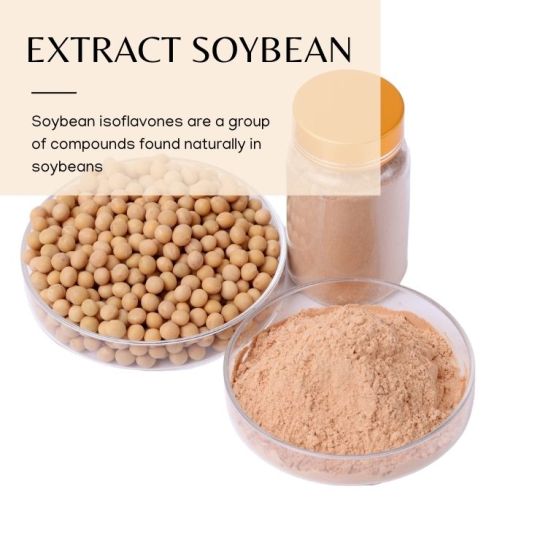
Extract soybean, Soybean Extract Powder
0 notes
Text
Some Vegetarian Meals for a Happy Mind

Food has a significant impact on how our bodies, both physically and mentally, are organized. A diet that benefits the mind can support both short-term and long-term functions. Indeed, we eat food for health. You can support the health of your brain by including a variety of food items in your diet. Learn about the six vegetarian options in this article.
1. Dark chocolate
Flavonoids are found in cocoa in dark chocolate; It is an antioxidant type. Because the brain is extremely susceptible to oxidative stress, antioxidants are excellent for brain health. Brain disorders and cognitive decline with age are both caused by this stress. Additionally, eating dark chocolate may increase brain plasticity, which is essential for learning. Dark chocolate is delicious food for sleep well.
2. Berries
A flavonoid antioxidant that is beneficial to brain health can also be found in berries. Because they aid in the reduction of oxidative stress and inflammation, antioxidants are essential for our brains. Antioxidants found in the brain include quercetin, anthocyanin, catechin, and coffee acid.
All these antioxidants have a positive impact on the brain, which includes:
Reducing age-related brain diseases and cognitive decline
Reducing inflammation throughout the body
Enhance the communication between the brain cells.
3. Whole grains
Whole grains are necessary for improving brain health as well as for the physical development of our bodies. Vitamin E, which ultimately aids in improving brain health, is abundant in whole grains. Whole grains, which are beneficial, are found in items like barley, whole-grain pasta, and whole-grain bread food for a healthy body and mind.
4. Avocados
There are numerous health benefits to avocados. In addition to supporting brain health, it is the best source of healthy unsaturated fat. Because they lower blood pressure, these monounsaturated fats lower the risk of brain hemorrhage. Cognitive decline can result from high blood pressure. As a result, if you eat avocados, you can lower your blood pressure. It acts as a nutrient-rich food for health skin also.
5. Broccoli
A vegetable that is frequently regarded as nutritious is broccoli. This is due to the fact that it is a low-calorie source of dietary fiber, which is beneficial to our brains as well as to our physical health. Isothiocyanates, which are excellent for reducing oxidative stress and lowering the risk of brain diseases, are produced when glucosinolates in broccoli are broken down in the body. Other cruciferous vegetables, such as bok choy, brussels sprouts, and cabbage, which contain glucosinolates and are excellent, are present in addition to broccoli food for well-being and brain health.
6. Soy products
Polyphenols, a type of antioxidant found in soy beans, have been shown to improve cognitive function and lower the risk of dementia. Genistein and daidzein are two examples of polyphenols, also known as isoflavones, found in all soy products. The brain, as well as the rest of the body, benefits greatly from these antioxidants. It ranks among the best food for wellness.
Wrap up
The brain, as the body’s most important organ, requires the same level of care and attention as the other organs. However, it is frequently overlooked. It is essential to include foods high in nutrients in your diet if you want your brain to continue to function normally over time food for a healthy life.
0 notes
Text
Neonatal anti-biotic direct exposure hinders child progress throughout the very first six years of lifestyle by simply perturbing intestinal tract microbial colonization.
This specific papers offers a quick evaluation and also commentary about the current advanced with the aspiration that it will aid supply framework for other people in picking, enhancing as well as building these types of essential tools for analysis along with determines. (Chemical) 2013 Elsevier W./. Just about all rights set aside.Previous microarray studies says throughout Bradyrhizobium japonicum, with regards to Hundred family genes are usually induced by simply genistein, a great isoflavonoid produced by soybean. Including a few body's genes freC, freA, and also freB (organized designations bll4319, bll4320, and also bll4321), which can be likely to kind a new genistein-, daidzein-, along with coumestrol-inducible operon and also to scribe the multidrug efflux program. Upstream of freCAB along with the alternative alignment, FrrA (methodical status Blr4322), that has similarity to TetR-type regulators, is actually protected. The removal regarding frrA results in elevated appearance regarding freB without a great inducer. All of us recognized the correct translational start off codon associated with frrA along with established that your gene will be inducible by genistein as well as daidzein. The particular proteins, which has been heterologously depicted as well as pure coming from Escherichia coli, holds or two palindrome-like Genetic make-up components (owner A new along with operator B), which are located in the intergenic area involving freC as well as frrA. The particular replacing several nucleotides or perhaps the installation of more spacer nucleotides averted joining. Binding involving FrrA have also been selleck products affected by digging in genistein. By simply mapping the transcription start sites, many of us discovered that agent A insures the transcriptional begin internet site regarding freC along with agent N may perhaps be positioned relating to the -35 regions of the two divergently driven body's genes. Agent A new is apparently maintained in certain equivalent gene constellations in various other proteobacteria. Each of our info indicate in which within W. japonicum, in addition to NodD1 (the LysR family) and NodVW (a two-component response regulator), a third regulator type (a TetR family member) which responds to the plant transmission compounds genistein and daidzein is available.Is designed: The examine tackled the particular influence associated with earlier inflammatory periods involving person suffering from diabetes renal system illness: leukocyte bond and monocyte activation (while examined simply by intercellular leukocyte adhesion molecule-ICAM-1 and also monocyte chemoatractant protein-MCP-1) on the a higher level albuminuria. Lcd degrees of adiponectin, a prospective anti-inflammatory counteracting mechanism, had been additionally researched in link towards the above-mentioned cytokines. Methods: 79 consecutive type 2 diabetic outpatients and also 46 regulates were integrated. Routine laboratory examination, urinary : albumin to be able to creatinine proportion (uACR), lcd adiponectin, plasma tv's ICAM-1 along with the urinary system MPC-1 were evaluated. Results: Inside numerous regression ICAM-1 (p Is equal to 0.004) as well as adiponectin (r Equates to 2.2008) ended up the key factors of uACR. Plasma televisions adiponectin really related in order to ICAM-1 (r Equals 2.03, r Equates to 3.Twenty four). In albuminuric people (uACR >= 25 mg/g) plasma tv's adiponectin was drastically larger compared to normoalbuminuric versions (uACR <30 mg/g). In albuminuric individuals the main determinants involving uACR had been lcd ICAM-1 as well as adiponectin. Inside numerous regression ICAM-1 may be the merely one which holds mathematical value (r Equates to 3.
#GPCR Compound Library#Androgen Receptor Antagonist#Vinorelbine#Hydrocortisone#Melatonin#Fluoxetine#Favipiravir#Dabigatran#Apixaban#Nitazoxanide#PMA#Pexidartinib#MG132#Rapamycin#Navitoclax#Telaglenastat#Mirdametinib#PEG300#Entinostat#Galunisertib#CL 59806#TKI-258#SHR-1258#NMS-P937#PLB-1001#NP031112#ABL001#IMI 28#SC 58635#NSC 113928
0 notes
Text
Soy Isoflavones Market - Forecast (2022 - 2027)
Soy Isoflavones Market size is estimated to reach $436.9 million by 2027, growing at a CAGR of 4.7% during the forecast period 2022-2027. Isoflavones are commonly delineated as phytostrogens as they are derived from plants and fall under the category of polyphenolic compounds and share estrogen-like structure and effect. Soy isoflavones are mined from bark, leaves, and other parts of the plant. Besides soybeans, other legumes crops such as peanuts, chickpeas, and red clover are rich sources of these polyphenolic compounds. Glycosides like genistin, glycitin, and daidzein are present in soybeans that make it of utmost importance in the prevention of many cardiovascular complications, osteoporosis, and hormone-dependent cancer. Over the year, clinical studies have proven that augmented consumption of such phytoestrogens supports the alteration of endogenous estrogen into protective 2-hydroxylated estrogens extends its helping hand in dropping breast proliferation stimulants, thereby, eventually, reducing the risks of breast cancer prevalence in women. The soy isoflavones market outlook is fairly impressive and is attributable to budding usage of isoflavones in dietary supplements pertaining to the antimicrobial and anticancer properties of isoflavones. Accruing prevalence of cancer, gastrointestinal infections, bone illnesses such as osteoporosis, diabetes, and cognitive impairment are factors set to drive the growth of the Soy Isoflavones Industry for the period 2022-2027.
Request Sample
Report Coverage
The report: “Soy Isoflavones Market Forecast (2022-2027)”, by Industry ARC, covers an in-depth analysis of the following segments of the Soy Isoflavones Market.
By Form: Wax, Liquid, Capsules, and Powder.
By Application: Pharmaceuticals (dietary supplements, medicines, and cosmetics), Food and beverages, Nutraceuticals.
By Packaging: Blister packaging, Alu-Alu strip, HDPE bottles, Polybags, Stand-up pouches, and others.
By Distribution Channel: Offline and Online Platforms.
By Geography: North America (U.S., Canada, and Mexico), Europe (Germany, UK, France, Italy, Spain, Russia, and Rest of Europe), Asia-Pacific (China, India, Japan, South Korea, Australia & New Zealand, and Rest of Asia-Pacific), South America (Brazil, Argentina, and Rest of South America) and Rest of World (the Middle East and Africa).
Key Takeaways
Geographically, the Asia-Pacific Soy Isoflavones Market accounted for the highest revenue share in 2021 and it is poised to dominate the market over the period 2022-2027.
Expanding disposable income levels and mounting health cognizance among people is said to be preeminent driver driving the growth of the Soy Isoflavones Market. Unfavorable climate conditions owing to environmental challenges, adverse effects of overusing soya, and vulnerable manufacturing activities are said to reduce the market growth.
Detailed analysis on the Strength, Weaknesses, and Opportunities of the prominent players operating in the market will be provided in the Soy Isoflavones Market report.
Inquiry Before Buying
Soy Isoflavones Market Segment Analysis-By Application
The Soy Isoflavones Market based on the application type can be further segmented into pharmaceuticals, food and beverages, nutraceuticals. The pharmaceuticals segment held the largest share in 2021. The growth is owing to the widescale use of soy isoflavones in the fabrication of medications. Soy isoflavones have been proven beneficial in menopausal symptoms which come from progesterone and estrogen changes. On another hand, the antioxidants, anti-inflammatory, and anti-cancer properties of such polyphenolic compounds have drawn the eyes of the pharmaceutical industry toward them. The intake of the prescribed dosage of isoflavones helps lower bad cholesterol levels, muscle soreness, and cancer complications. Moreover, it too condenses the blood sugar levels in patients afflicted with diabetes. Therefore, shooting up usage of isoflavones in manufacturing drugs has provided a growth platform for the segment. Nevertheless, the pharmaceutical segment is estimated to be the fastest-growing segment with a CAGR of 4.9% over the forecast period 2022-2027. This growth is owing to the heightening intake of protein powders especially among millennials. The trend of dietary supplements’ consumption has escalated in recent years to fulfill the nutrient requirement. Such supplements help in tissue repairment, enzyme production, and strengthening the muscles. Also, rising aesthetic awareness is adding its fair contribution to the growth of the pharmaceutical segment.
Soy Isoflavones Market Segment Analysis-By Distribution Channel
The Soy Isoflavones Market based on distribution channels can be further segmented into offline platforms and online platforms. The offline segment held the largest share in 2021. The growth is owing to the across-the-board presence of offline segments such as retail pharmacies. With rapid modernization, a dramatic swing in attitudes of people from treatments to preclusion can be observed. Consequently, broadening health alertness among people is reassuring them to undertake all essential measures far in advance. Nevertheless, the online segment is estimated to be the fastest-growing segment with a CAGR of 5.7% over the forecast period 2022-2027. This growth is owing to digitalization and ameliorating online platforms, allowing more players to become a part of the market. On another hand, eventful lives of people encourage them to make online purchases as it extends additional conveniences and saves overall time. Better internet connectivity has its equitable share in connecting rural areas to cities. As a result, the overall magnitude of the tech-friendly population is rising worldwide. As of 2021, China had 953.9 million smartphone users, whereas, India grabbed the second spot with 492 million users. Therefore, considering the relentless pace of urbanization, these numbers are likely to outperform their prior shelves in upcoming years.
Buy Now
Soy Isoflavones Market Segment Analysis-By Geography
The Soy Isoflavones Market based on Geography can be further segmented into North America, Europe, Asia-Pacific, South America, and the Rest of the World. The Asia-pacific segment held the largest share with 37% of the overall market in 2021. The growth in this segment is owing to the factors such as the existence of the biggest soybean consumers such as China, India, Bangladesh, and others. China was the leading consumer of soya oil in 2021 with more than 18,000 metric tonnes of consumption, whereas, India and Bangladesh collectively consumed over 6500 metric tonnes. On another hand, if we talk about production China holds 4th position worldwide in the production of (genetic modification) GM-free soya. Besides, a larger chunk of the Chinese and Japanese population is turning old and consequently heightening the demand for soy isoflavones owing to their health benefits. In 2021, 30%of the total Japanese population and more than 18% were old. The number is expected to rise in the upcoming future. Moreover, the Asia-pacific segment is expected to be the fastest-growing segment over the forecast period 2022-2027. This growth is owing to improving farming techniques and broadening of the disposable income of people.
Soy Isoflavones Market Drivers
Rising Cancer prevalence is Anticipated to Boost Product Demand
The widespread prevalence of cancer is a major driver for the aforementioned market. According to a Word health Organization report, after heart problems, cancer is the biggest reason for deaths around the globe. Last year it claimed more than 10 million lives. According to a study, around 12-13% of women in the U.S grow breast cancer complications in their lifetime. Similarly, more than 280,000 new cases are expected to be identified this year in the U.S. Besides cancer, osteoporosis cases are surging pertaining to the rising number of geriatrics. More than 200 million people worldwide are suffering from bone hitches. All these aforementioned factors are casting votes in favour of the soy isoflavones market as soy has properties to avert the prevalence of complications.
Upsurging health awareness and the use of contemporary techniques in pharmaceutical production are Expected to Boost Product Demand.
Proliferating consciousness among people is providing a sound opportunity for the growth of the market. As life-threatening health maladies are reducing the overall lifespan and quality of life, people are making more rational and wise choices such as proper exercise, healthy ingestion habits, and proper nutrient intake. The fitness industry and supplements have an inextricable connection as the majority of gym members tend to consume dietary supplements to fulfill the requirement of nutrition. According to the IHRSA report, around 2.36% of the global population had a gym membership in 2021. As the number is rising steadily so is the growth in the soy isoflavones market. On another hand, the use of contemporary techniques like nanotechnology in the fabrication of active pharmaceutical ingredients has a decent amount in the growth of the market.
Soy Isoflavones Market Challenges
Environmental problems, side effects connected with overuse, and hampered manufacturing globally are Anticipated to Hamper Market Growth.
Hackneyed use of soy isoflavones may set health complications like constipation, queasiness, swelling, itching, rashes, breathing difficulties in motion. On another hand, climate change, and environmental compilation like widespread drought, floods, and disrupted duration of seasons can impact the yield adversely. Also, the soil is losing its richness and fertility owing to the heightened use of pesticides and other chemicals. Moreover, stalled manufacturing processes owing to the reimposition of lockdowns are posing another challenge in Infront of the soy isoflavones market.
Soy Isoflavones Industry Outlook
Product launches, mergers and acquisitions, joint ventures, and geographical expansions are key strategies adopted by players in the market. Soy Isoflavones top 10 companies include:
Nexira
DSM
Bio-gen Extracts
BASF
Cargill
SK Bioland Co.
Novapac laboratories
NutraScience labs
ADM
Frutarom Industries
Recent Developments
On November 2, 2021, US-based natural ingredient and botanical extracts company, “Nexira” announced the successful acquisition of Eschenz, Switzerland-based natural-food and premium ingredient manufacturing firm “Unipektin.” The financials of the deal were not disclosed. However, the acquisition strengthened the food and nutrition portfolio of Nexira.
On August 9, 2021, two food companies have signed an agreement to acquire the US-based company “Sanderson farms.” The first company is Minnesota-based “Cargill, Inc.” and the second firm “Continental Grain Company” is based in Belgium. Both firms agreed to pay an amount of $4.53 billion collectively to Sanderson in order to complete the acquisition process. Every existing shareholder of Sanderson receive $203 for every single share they were holding.
On October 2, 2020, Heerlen, Netherland-based “Royal DSM”, a company which is famous for its nutrition and personal care products, publicized that it has acquired the “Erber Group.” The total value of these transactions stands around 980 million euros. Moreover, under the transaction, DSM gets access to Bomin and Romer labs of the Erber group.
0 notes
Text
Articles of soil-derived as well as throughout garden soil biota as well as wildlife residing around dirt area: Significance regarding radioactive squander.
S.) ended up watched inside a selected-ion effect (SIR) function having a beneficial electrospray ion technology (ESI) user interface by the pursuing ions: m/z 417.A couple of pertaining to puerarin, m/z 255.Two regarding daidzein, m/z 271.3 regarding baicalin, m/z 461.0 with regard to wogonoside, m/z 441.Zero pertaining to liquiritin and also m/z 237.A couple of for carbamazepine (My partner and i.S.), correspondingly. The standardization shapes of such analytes had been linear over the focus ranges from 2.00254-1.02 mu g mL(-1) to 0.0102-10.Only two mu gary milliliters(-1). Within-batch and also between-batch precisions (RSD%) were all inside of 15% and accuracy and reliability (RE%) varied from -10% for you to 10%. The actual removal recoveries were typically Seventy nine.8% with regard to puerarin, Ninety days.8% for daidzein, Seventy four.4% pertaining to baicalin, 75.2% for wogonoside and Eighty four.7% regarding liquiritin. The validated method ended up being properly applied to investigate pharmacokinetics of five bioactive substances regarding GegenQinlian decoction (GQD) throughout rats. (D) 09 Elsevier W.V. Just about all legal rights set aside.Little ones together with Chiari malformations can instruct using typical symptoms, including coughing or drooling, which can be associated with the respiratory system ailments, delaying a proper diagnosis. Presentation will differ as we grow older, and so can be diverse in older children in comparison to newborns. Many of us found 2 installments of unconventional demonstrations inside preschoolers and look at the literature by having an concentrate on severe demonstration regarding Chiari in numerous age groups in kids.Release: In today's study, all of us looked into the end results regarding breast-feeding period upon bone tissue vitamin occurrence (BMD) down the road. Material and methods: The actual study took it's origin from a retrospective evaluation Lonafarnib of 586 postmenopausal girls having a suggest day of 60.8 a long time, who have been screened-in for brittle bones through dual electricity X-ray absorptiometry (DXA). We were holding classified straight into 4 groups with respect to the amount of his or her breast-feeding as never ever (team One particular), 1-24 months (group 2), 25-60 months (team Several), as well as > 5 years (group Four). Bone tissue nutrient density recent results for the actual femur guitar neck and back backbone have been classified directly into 3 organizations based on That conditions as normal (To credit score > -1.3 SD), osteopenia (To credit score -1.2 in order to -2.A few SD), as well as osteoporosis (To report < -2.Five SD). Sufferers using osteopenia as well as weak bones (T credit score < -1.0 SD) ended up viewed as having low bone tissue bulk (LBM). Results: Many of us identified any correlation involving duration of lactation and femur BMD or even back BMD inside the research human population (3rd r Equals 0.116, s < 3.005; r Is equal to -0.151, p Equals Zero.001, correspondingly). Considerable variances were found among femur BMD along with back BMD regarding groupings inside one-way ANOVA analysis (g Is equal to 2.025, s Equates to 0.005, respectively). Moreover, when compared to another three groupings, team Several had been more mature along more time use of the menopause (p < 3.
#GW4064#STO-609#WNK463#NSC697923#GSK2256098#GSK1838705A#EPZ005687#Eflornithine#MMAF#Telratolimod#Cerdulatinib#LY3009120#SCH-442416#Lomitapide#WZB117#Dutasteride#Selitrectinib#Zosuquidar#UNC1999#Tiplaxtinin#Odanacatib#Brusatol#Montelukast#Selumetinib#SGI-1776#T0901317#E6446#Melphalan#MLN2480#LY3298176
0 notes
Text
0 notes